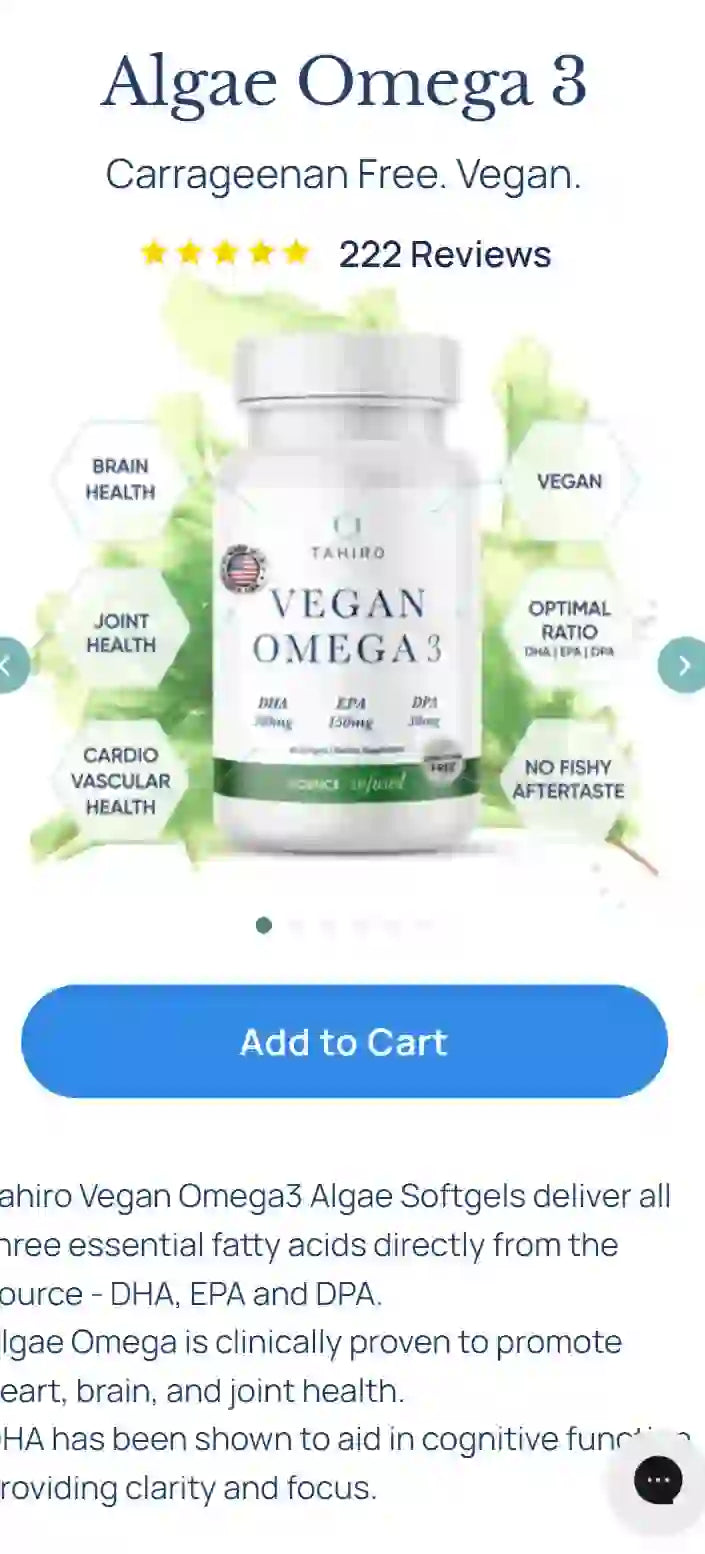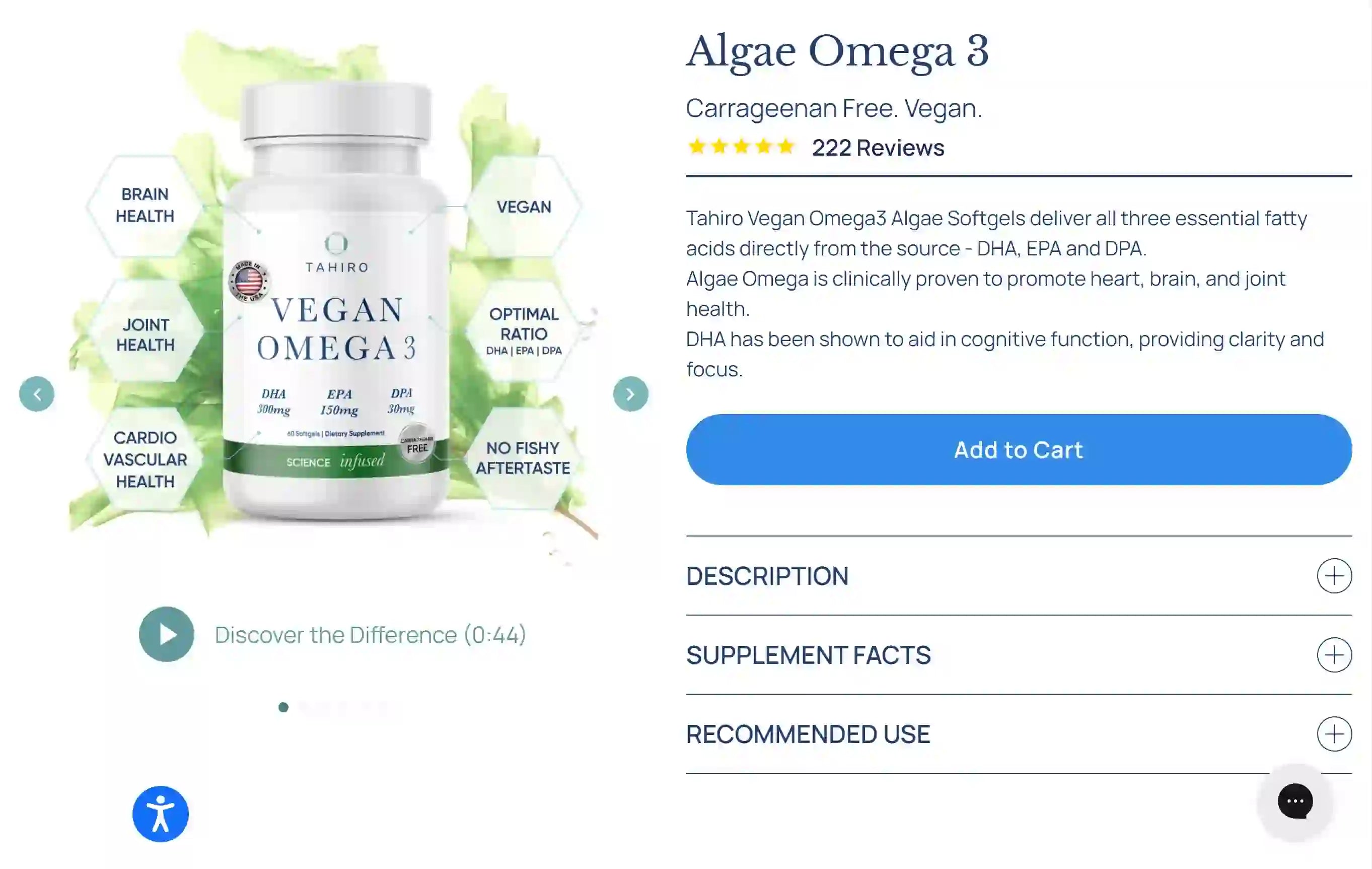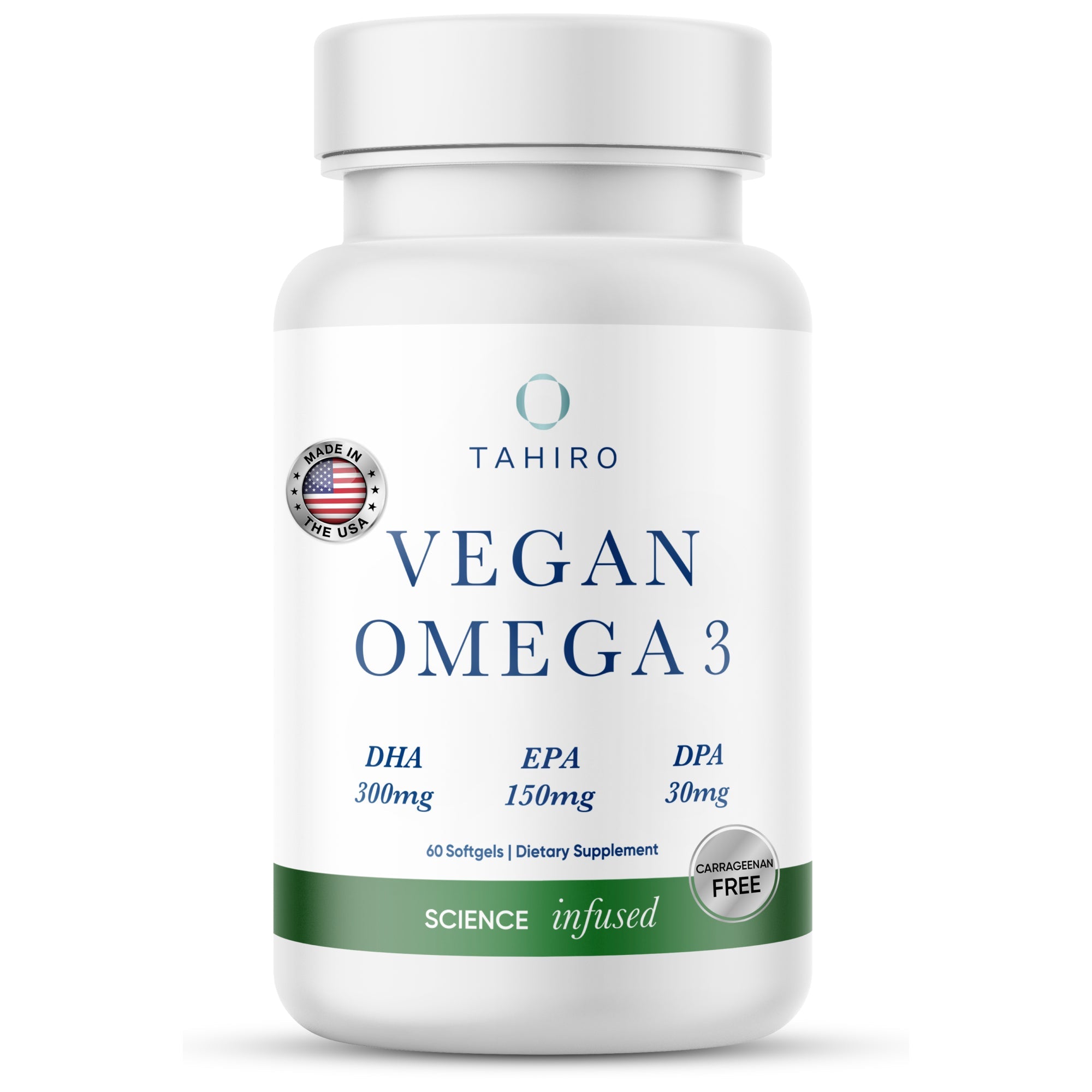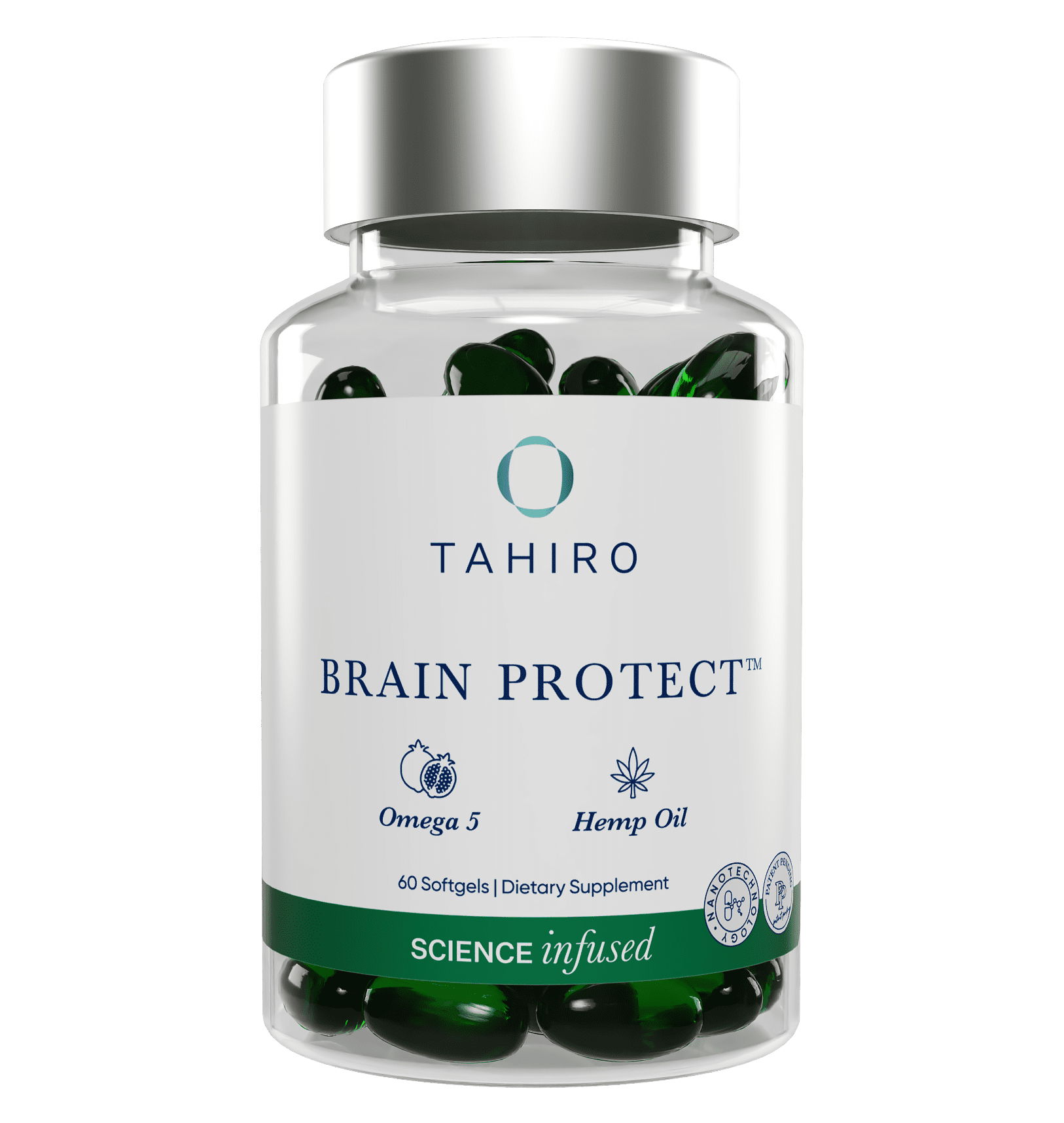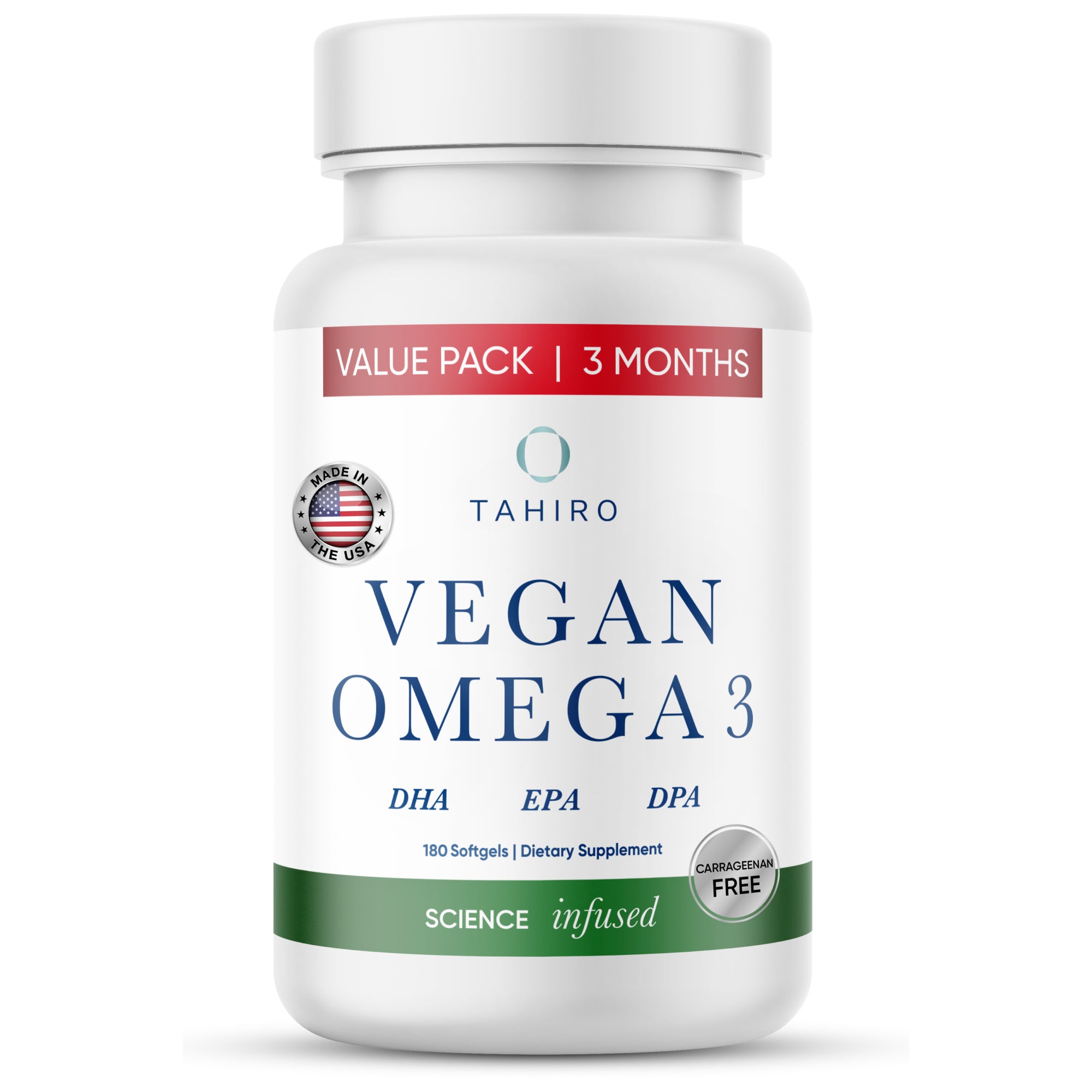Algae are much more complex than you might think. Algae itself includes 40,000 species 1 that are microscopic organisms called microalgae to kelp and seaweed. Many algae are cultivated in large farming ponds. Eating enough algae to get adequate Omega-3 consisting of eicosapentaenoic acid (EPA) and docosahexaenoic acid (DHA) can be challenging. That’s why supplements are the best source of adequate Omega-3, EPA, and DHA.
What are omega-3 Fatty Acids?
Omega-3 fatty acids are essential to the functioning of your body and brain. Omega-3s provide energy and are found in high concentrations in your eyes and brain.
There are three main types of Omega-3 fatty acids 2:
- EPA (eicosapentaenoic acid). EPA is a marine omega-3 found in fish.
- DHA (docosahexaenoic acid). DHA is also found in fish.
- ALA (alpha-linolenic acid) which is a form of omega-3 found in plants.
What are examples of omega-3 fatty acids?
Omega-3 fatty acids are in foods such as flaxseed, soybeans, and canola oils, fish, and dietary supplements. ALA is plant-based, and DHA and EPA are fish based. ALA is an essential fatty acid you must get from food since your body can’t produce it, so you must get it from food sources. Some food sources of Omega-3s include
- Cold water fish such as salmon, tuna, sardines, herring, and mackerel.
- Seeds, and nuts including walnuts, chia seeds, and flaxseed.
- Plant oils like canola, flaxseed, and soybean oils
- Foods that are fortified with Omega-3s
A Natural Source of Omega-3 Fatty Acids: Algae
Algae and fish oils are the primary sources of omega-3s. Algae are vegetarian and, for vegans, might be a better choice. In one study 3, algae oil supplements were found to have the same nutritional value and benefits of salmon. Another 2-week study 4 in 31 people, showed that “taking 600 mg of DHA from algae oil per day raised blood levels the same percentage as taking an equal amount of DHA from fish oil.”
Which algae are a source of omega 3?
Algae and seaweed are important for people who are vegetarian or vegan because they are one of the few plant foods containing both DHA and EPA.
The forms of algae are seaweed, nori, spirulina, and chlorella. Let’s look at each of these in the context of their Omega-3 content.Seaweed
Types of seaweed that all have Omega-3 are
-
nori: is dried seaweed and has EPA, an important source of Omega-3.
-
kelp: refers to brown algae from the Laminariaceae family. Kelp is used in Japanese dishes, including miso soup and udon.
-
wakame: wakame and nori are macroalgae, which are large algae. There are three kinds of macroalgae: brown, red, and green. Nori is a type of red algae. Wakame is a brown alga, which we commonly call kelp.
-
kombu: is dried edible kelp.
-
dulse: is a red algae that grows in the Atlantic and Pacific oceans and is also referred to as sea lettuce. also known as sea lettuce.
-
spirulina: provides a small amount of fat, including both omega-6 and omega-3 fatty acids 5 in an approximately 1.5–1.0 ratio.
What is the best algae for omega 3?
Because fish can’t produce EPA and DHA, they get it by eating microalgae. So, the source of Omega-3s in fish comes from algae.
Microalgae from the Schizochytrium (a DHA-rich fish oil alternative containing small amounts of EPA) and Nannochloropsis genera (“marine microalgae with high photosynthetic efficiency and can convert carbon dioxide to storage lipids mainly in the form of triacylglycerols and to the ω-3 long-chain polyunsaturated fatty acid eicosapentaenoic acid (EPA) are particularly high in omega-3 fatty acids, including DHA and EPA .
How can I ensure I'm getting enough omega-3?
It is estimated that 95% of people don’t get enough DHA and EPA from their diet 6 alone.
Guidelines for omega-3 intake 7 will vary depending on several factors, but there is no absolute on how much Omega-3 a person needs. Some of the factors or health conditions that can determine doses:
The current recommended amounts of Omega 3 8 are based on five factors from the National Institutes of Health.
*As total omega-3s **As ALA
|
Age
|
Male
|
Female
|
Pregnancy
|
Lactation
|
|
Birth to 6 months*
|
0.5 g
|
0.5 g
|
|
|
|
7–12 months*
|
0.5 g
|
0.5 g
|
|
|
|
1–3 years**
|
0.7 g
|
0.7 g
|
|
|
|
4–8 years**
|
0.9 g
|
0.9 g
|
|
|
|
9–13 years**
|
1.2 g
|
1.0 g
|
|
|
|
14–18 years**
|
1.6 g
|
1.1 g
|
1.4 g
|
1.3 g
|
|
19-50 years**
|
1.6 g
|
1.1 g
|
1.4 g
|
1.3 g
|
|
51+ years**
|
1.6 g
|
1.1 g
|
|
|
Which omega-3 algae supplement is best for me?
All supplements are not created equally. Now that you understand the importance of algae to overall health, cognition, and well-being Tahiro’s Algae Omega 3 is the best choice. Why? For these reasons:
- Consuming omega-3 fatty acids from algae-based supplements is getting them directly from the source rather than from fish that have accumulated them through the food chain. This method of consumption carries fewer potential risks compared to consuming fish, such as exposure to environmental toxins like mercury and PCBs.
- Algae-based Omega 3 supplements are more sustainable and ethical than fish oil supplements, as they do not contribute to overfishing or harm to marine ecosystems.
- Our Algae Omega 3 supplement is a plant-based alternative to traditional fish oil supplements, providing a sustainable and vegan-friendly source of these important nutrients. Omega-3 supports the production of neurotransmitters, the communication molecules that allow neurons to communicate with each other.
Omega-3 fatty acids are essential to the functioning of your body and brain. Omega-3s provide energy and are found in high concentrations in your eyes and brain.
There are three main types of Omega-3 fatty acids 2:
- EPA (eicosapentaenoic acid). EPA is a marine omega-3 found in fish.
- DHA (docosahexaenoic acid). DHA is also found in fish.
- ALA (alpha-linolenic acid) which is a form of omega-3 found in plants.
What are examples of omega-3 fatty acids?
Omega-3 fatty acids are in foods such as flaxseed, soybeans, and canola oils, fish, and dietary supplements. ALA is plant-based, and DHA and EPA are fish based. ALA is an essential fatty acid you must get from food since your body can’t produce it, so you must get it from food sources. Some food sources of Omega-3s include
- Cold water fish such as salmon, tuna, sardines, herring, and mackerel.
- Seeds, and nuts including walnuts, chia seeds, and flaxseed.
- Plant oils like canola, flaxseed, and soybean oils
- Foods that are fortified with Omega-3s
A Natural Source of Omega-3 Fatty Acids: Algae
Algae and fish oils are the primary sources of omega-3s. Algae are vegetarian and, for vegans, might be a better choice. In one study 3, algae oil supplements were found to have the same nutritional value and benefits of salmon. Another 2-week study 4 in 31 people, showed that “taking 600 mg of DHA from algae oil per day raised blood levels the same percentage as taking an equal amount of DHA from fish oil.”
Which algae are a source of omega 3?
Algae and seaweed are important for people who are vegetarian or vegan because they are one of the few plant foods containing both DHA and EPA.
The forms of algae are seaweed, nori, spirulina, and chlorella. Let’s look at each of these in the context of their Omega-3 content.Seaweed
Types of seaweed that all have Omega-3 are
-
nori: is dried seaweed and has EPA, an important source of Omega-3.
-
kelp: refers to brown algae from the Laminariaceae family. Kelp is used in Japanese dishes, including miso soup and udon.
-
wakame: wakame and nori are macroalgae, which are large algae. There are three kinds of macroalgae: brown, red, and green. Nori is a type of red algae. Wakame is a brown alga, which we commonly call kelp.
-
kombu: is dried edible kelp.
-
dulse: is a red algae that grows in the Atlantic and Pacific oceans and is also referred to as sea lettuce. also known as sea lettuce.
-
spirulina: provides a small amount of fat, including both omega-6 and omega-3 fatty acids 5 in an approximately 1.5–1.0 ratio.
What is the best algae for omega 3?
Because fish can’t produce EPA and DHA, they get it by eating microalgae. So, the source of Omega-3s in fish comes from algae.
Microalgae from the Schizochytrium (a DHA-rich fish oil alternative containing small amounts of EPA) and Nannochloropsis genera (“marine microalgae with high photosynthetic efficiency and can convert carbon dioxide to storage lipids mainly in the form of triacylglycerols and to the ω-3 long-chain polyunsaturated fatty acid eicosapentaenoic acid (EPA) are particularly high in omega-3 fatty acids, including DHA and EPA .
How can I ensure I'm getting enough omega-3?
It is estimated that 95% of people don’t get enough DHA and EPA from their diet 6 alone.Guidelines for omega-3 intake 7 will vary depending on several factors, but there is no absolute on how much Omega-3 a person needs. Some of the factors or health conditions that can determine doses:
- Gender
- Adult vs. pregnant adult, breastfeeding or children
- Heart health
- Depression
- Alzheimer’s disease
- Cancer
The current recommended amounts of Omega 3 8 are based on five factors from the National Institutes of Health.
*As total omega-3s **As ALA
|
Age
|
Male
|
Female
|
Pregnancy
|
Lactation
|
|
Birth to 6 months*
|
0.5 g
|
0.5 g
|
|
|
|
7–12 months*
|
0.5 g
|
0.5 g
|
|
|
|
1–3 years**
|
0.7 g
|
0.7 g
|
|
|
|
4–8 years**
|
0.9 g
|
0.9 g
|
|
|
|
9–13 years**
|
1.2 g
|
1.0 g
|
|
|
|
14–18 years**
|
1.6 g
|
1.1 g
|
1.4 g
|
1.3 g
|
|
19-50 years**
|
1.6 g
|
1.1 g
|
1.4 g
|
1.3 g
|
|
51+ years**
|
1.6 g
|
1.1 g
|
|
|
Which omega-3 algae supplement is best for me?
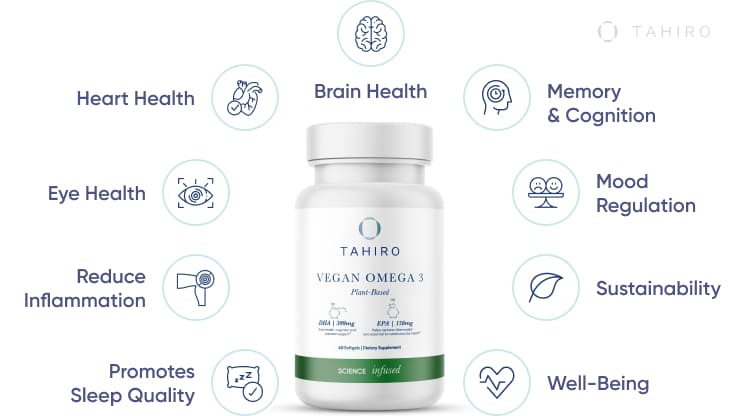
All supplements are not created equally. Now that you understand the importance of algae to overall health, cognition, and well-being Tahiro’s Algae Omega 3 is the best choice. Why? For these reasons:
- Consuming omega-3 fatty acids from algae-based supplements is getting them directly from the source rather than from fish that have accumulated them through the food chain. This method of consumption carries fewer potential risks compared to consuming fish, such as exposure to environmental toxins like mercury and PCBs.
- Algae-based Omega 3 supplements are more sustainable and ethical than fish oil supplements, as they do not contribute to overfishing or harm to marine ecosystems.
- Our Algae Omega 3 supplement is a plant-based alternative to traditional fish oil supplements, providing a sustainable and vegan-friendly source of these important nutrients. Omega-3 supports the production of neurotransmitters, the communication molecules that allow neurons to communicate with each other.
- Consuming omega-3 fatty acids from algae-based supplements is getting them directly from the source rather than from fish that have accumulated them through the food chain. This method of consumption carries fewer potential risks compared to consuming fish, such as exposure to environmental toxins like mercury and PCBs.
- Algae-based Omega 3 supplements are more sustainable and ethical than fish oil supplements, as they do not contribute to overfishing or harm to marine ecosystems.
- Our Algae Omega 3 supplement is a plant-based alternative to traditional fish oil supplements, providing a sustainable and vegan-friendly source of these important nutrients. Omega-3 supports the production of neurotransmitters, the communication molecules that allow neurons to communicate with each other.

